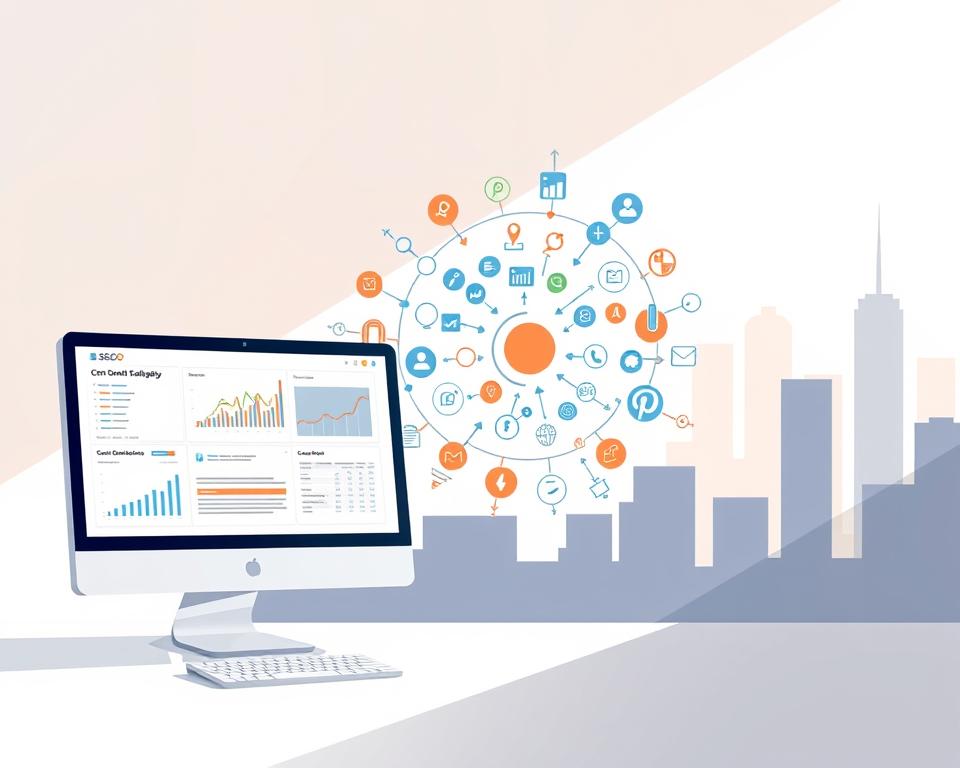The Transformation of Development of Online Marketing: A Odyssey
Were you aware that more than 170M individuals consistently engage with social media, successfully reshaping the marketing landscape? As buyers progressively transition online, digital marketing has surfaced as a essential approach. It permits companies to connect clients on venues where they allocate a substantial part of their attention. This shift indicates the transformation of online marketing transitioning from traditional practices to a more interactive and participatory approach.
With an estimated digital advertising industry value of around $200 billion, it’s apparent that Orlando Digital Marketing Company must adapt to the current online marketing trends. This is essential to maintain competitiveness in this rapidly changing landscape.
The growth of online channels has empowered companies to reach customers that traditional marketing methods have difficulty targeting. Gone are the days when a basic ad in a periodical would be enough. Currently, focused marketing approaches have gained prominence, using techniques like search engine optimization (SEO), social media platforms, and influencer alliances.
As we investigate the evolution of digital marketing, we will explore significant milestones and trends. These have formed the current marketing paradigm. We will demonstrate the unique opportunities and challenges faced by organizations in this digital era.
Key Takeaways
- Over 170M users consistently interact on digital platforms, establishing vast marketing opportunities.
- Online marketing proves to be cost-effective than conventional techniques, enabling extended reach with lower budgets.
- The global digital advertising market is projected to reach $517 billion by the end of 2023.
- Precision strategies like Search Engine Optimization improve web visibility and interaction for companies.
- Social media influencers have built a $1 billion sector, changing brand promotion.
- Companies employing mobile-focused marketing strategies can leverage the increasing consumer dependence on mobile devices.
- Investing in digital marketing tools, like Google AdWords, allows for precise targeting based on consumer demographics.
Introduction to Digital Marketing
Digital marketing covers a variety of marketing activities across diverse online platforms. This encompasses social networks, electronic mail, search platforms, and online sites. It’s a essential aspect of current marketing, considering the growing internet engagement between consumers and brands. Companies that comprehend the basics of online marketing can create strategies that successfully engage with their intended audiences.
The development of internet marketing is powered by evolving customer behaviors. The arrival of smartphones has changed marketing and sales. Currently, businesses employ omni-channel strategies to meet the demands of customers who use multiple devices and platforms. Given the attention spans of young adults and Generation Z, content pieces must be captivating and effective from the onset. Findings suggest that integrating videos can boost message impact by up to triple.
The increasing role of digital marketing underscores the necessity to keep up of emerging trends and technologies. Instruments like artificial intelligence chatbots enable deep customer interaction, while digital influencers aid foster trust with customers. Traditional marketing methods are no longer enough, highlighting the crucial nature of integrated digital strategies that satisfy today’s buyer needs.
| Element | Information |
|---|---|
| Consumer Behavior | Shift towards digital engagement, decreased focus durations (twelve seconds for young adults, eight seconds for Gen Z) |
| Technology Adoption | Growth of mobile devices, expansion of engaging technologies |
| Promotional Strategies | Concentration on multi-channel and influencer marketing |
| Engagement Instruments | Utilizing artificial intelligence chatbots and video pieces in advertising campaigns |
| Market Evolution | Expansion of digital advertising since 2000, introduction of PPC advertising with platforms like Google Ads |
What is Digital Marketing?
Digital marketing includes a range of tactics to engage audiences through digital channels. It covers SEO strategies, content strategies, and social media interaction. The main aim is to effectively reach and engage with target audiences using vast data and cutting-edge technologies.
The increase of digital advertising has been notable in the past few years. As businesses dig deeper into the online world, the necessity for effective online marketing tools grows. For illustration, fifty-three percent of all online traffic comes from organic search results, emphasizing SEO’s importance in boosting visibility and traffic.
Content marketing innovations are essential to a brand’s communication with prospective customers. The content marketing sector is expected to hit two trillion dollars by 2032. It’s crucial for businesses to adjust their strategies to effectively utilize these programs. Compelling content fosters connections, enhancing brand loyalty and recognition.
Moreover, the importance of comprehensive CRM tools has increased. Organizations that utilize customer insights can develop targeted marketing campaigns. This leads to enhanced engagement and sales conversions.
In conclusion, online marketing is a constantly changing driver for companies looking to boost their digital footprint. By embracing the newest in online advertising and cutting-edge content marketing, businesses can increase brand visibility and attain increased consumer engagement.
Progression of Digital Marketing
The advertising landscape has seen a substantial transformation over the years. The development of online marketing demonstrates how the web has transformed business communication with customers. As classic techniques turned obsolete, digital channels arose, providing novel methods to engage consumers and assess performance.
Transitioning from Traditional to Digital: A Significant Change
The move from traditional to digital marketing has substantially changed the marketing sector. Traditional methods like print advertising, radio, and TV presented limited interaction. Online advertising, nevertheless, permits live interaction and performance metrics. The first clickable banner ad in 1994 signified the beginning of digital marketing as we recognize it today.
This change enabled businesses to pilot and enhance their approaches, leveraging the internet to interact with consumers.
The Birth of the Internet and Digital Marketing
The birth of the internet ushered in a new advertising era. In the beginning, businesses developed online sites, setting the stage for online marketing. The end of the 1990s witnessed the rise of search platforms like Yahoo and AltaVista, highlighting the importance of SEO in online marketing.
This change created new opportunities for accessing audiences actively searching for offerings, fundamentally changing consumer-brand interactions.
| Date | Achievement | Effect on Digital Marketing |
|---|---|---|
| 1994 | Initial clickable banner ad on HotWired.com | Foundation of online advertising |
| 1998 | Growth in search engine usage | Introduction of SEO as a marketing tool |
| 2002 | Google launches AdWords | Changed online advertising with PPC |
| 2004 | Facebook introduced | Provided vast engagement opportunities |
| 2007 | Launch of the iPhone | Resulted in the growth of mobile marketing |
| 2012 | Content marketing gains recognition | Valuable and relevant content becomes crucial |
1990s: The Beginning of Digital Marketing
The Nineties were a groundbreaking period for advertising, setting the stage for today’s digital world. The initial website was launched in 1991 by Tim Berners-Lee, indicating a crucial transformation in brand-audience connections. Search platforms became vital for navigating the growing online world.
Major Milestones of the 1990s
Several key moments shaped the 1990s, laying the groundwork for digital marketing’s future:
- 1991: The creation of the initial website sparked a increase in interest in digital content.
- 1994: The launch of the initial clickable banner ad opened the door to online advertising.
- Early search tools like Archie search emerged, offering internet users a way to find internet information.
- Platforms like Yahoo Search rose, heavily impacting the online user experience.
Search Engines’ Influence
The 1990s experienced a major influence from search engines. As companies realized the benefit of web visibility, SEO became vital. Brands adjusted to search engine developments to boost their visibility to clients. This signified a transition from simple brand awareness to a focus on visibility and engagement, highlighting the essential role of search engines in advertising.
2000s: The SEO and Social Media Transformation
The 2000s witnessed a significant shift in online marketing, propelled by the rise of SEO and social media. Companies concentrated on enhancing their digital presence, causing a surge in SEO methods. These modifications reshaped how companies communicate with consumers and how marketing strategies developed.
Growth of SEO (SEO)
Businesses understood the value of search tools as principal data sources. SEO evolved into vital, with sites emphasizing information and keyword optimization. The early 2000s introduced PPC advertising, expanding digital marketing options. This laid the groundwork for advanced analytics and extensive data in marketing.
The Rise of Social Media Platforms
Channels like Facebook, Twitter, and LinkedIn became widely used mainstream, altering social media. They enabled businesses to interact with audiences and offer personalized ads. The late 2000s decade also saw the rise of mobile marketing, with the increase of smartphones influencing strategies.
With exceeding 170M daily users, social media’s effect on brand visibility was huge. Marketers commenced working with influencers, increasing brand awareness and sales. Social media turned into a essential part of modern digital marketing.
The Impact of Online Advertising Advancements
The digital advertising landscape has undergone a major change with the advent of online advertising advancements. Programmatic advertising has changed how brands engage with their audience. In the U.S., more than 90% of digital display ads depend on programmatic methods for success. This innovation enables targeted ad delivery, guaranteeing the correct message attains the intended consumer.
Online marketing trends show a increase in native advertising efficiency. This approach, blending ads into user experiences, often exceeds traditional methods in engagement. Additionally, employing mobile app advertising has turned into crucial, accessing the viral capability of these platforms to increase visibility.
Augmented reality in content marketing is growing. It merges digital content with real-world environments, crafting engaging experiences. PWAs also focus on user experience, emphasizing speed and clarity, meeting current consumer demands.
With nearly 315 million Americans active on social media in 2023, mobile optimization is more critical than ever. A significant portion of advertising budgets is allocated to mobile ads, recognizing the extensive time users spend on their devices. This shift not only enhances user experience but also increases conversion rates, fueling revenue growth.
The adoption of AI tools has substantially advanced online advertising. Tools like Albert permit predictive analysis for pay-per-click campaigns, aiding marketers improve strategies with real-time data. AI-driven automation enhances marketing efficiency, permitting brands to stay competitive in a fast-changing market.
- Automated advertising enhances targeting efficiency.
- Inherent advertising often outperforms traditional methods.
- Augmented reality develops engaging marketing experiences.
- Mobile promotion concentrates on optimizing user experience.
- AI tools deliver predictive insights for campaigns.
Adapting to online marketing trends guarantees brands remain competitive in the continually shifting digital landscape.
2010s : Period of Personalization
The 2010s saw a major shift in digital marketing, with a focus on personalization. Improvements in data analytics allowed organizations to adapt their marketing to fit individual preferences and behaviors. This period emphasized the value of creating content that resonates with users, increasing engagement and loyalty.
Targeted Marketing Strategies
Marketers in this decade looked to customer data to create targeted campaigns. By understanding consumer behavior, brands could send personalized messages on various platforms. Personalization efforts included:
- Flexible website content that adapts based on user interactions.
- Tailored email campaigns adapted to individual preferences.
- Behavioral retargeting ads that follow users across the web.
This focus on targeted marketing helped brands connect with their audience more deeply. It resulted in higher customer satisfaction and conversion rates.
The Importance of Analytics in Marketing
Data Analysis became crucial in the 2010s, helping businesses turn vast data into useful insights. Companies used analytics to track campaign success, user engagement, and predict future behavior. Key aspects included:
- Utilizing predictive analytics to foresee customer needs and trends.
- Employing A/B testing to improve advertising approaches based on real-time data.
- Integrating social media analytics to gauge audience sentiment and preferences.
The increase of data analytics changed how marketers strategized, allowing them to create more relevant and engaging experiences. This evolution set the stage for future trends, solidifying a customer-centric approach in digital marketing.
The Effect of Mobile Technology
The increase of mobile technology has significantly altered the digital marketing landscape. In recent years, the shift towards mobile devices, especially smartphones, has altered consumer engagement with brands and information access. By 2021, about 85% of Americans possessed smartphones, a significant jump from 35% in 2011. This increase in mobile device usage has caused changes in digital marketing strategies across various sectors.
As mobile technology evolves, brands have grown their investment in mobile ads. An astonishing $7 out of every $10 spent on advertising now goes to mobile ads. In 2020, mobile ads made up around 70% of all internet ad revenues. This shows a clear consumer preference for mobile-friendly experiences. Businesses have therefore focused on responsive web design and mobile optimization for seamless interactions.
- 15% of Americans depend solely on their smartphones for internet access.
- Mobile optimization has become essential for consistent user experiences across devices.
- Social media platforms like Facebook and Instagram have utilized mobile technology to boost brand visibility.
- Data-driven marketing strategies enable better understanding of customer preferences.
The progression of digital marketing has also seen a transition towards personalized and targeted marketing. This has led to better engagement and conversion rates. Analytics tools have become crucial for marketers looking to tailor their campaigns effectively. Innovations like virtual reality (VR) and augmented reality (AR) have opened new avenues for customer engagement, emphasizing the dynamic relationship between mobile technology and digital marketing strategies.
Looking ahead, future trends will continue to merge technology and marketing innovation. Google’s decision to eliminate third-party cookies in 2023 will demand businesses to adapt their smartphone marketing tactics. Ethical concerns around data protection will mold consumer trust and influence marketing practices. As consumer behaviors transform with mobile technology, brands must stay flexible to embrace emerging opportunities within the evolving digital marketing landscape.
Present Digital Marketing Trends
The progression of digital marketing is continuing, with several trends influencing how businesses interact with consumers. Artificial intelligence and machine learning are transforming marketing strategies. These technologies facilitate more personalized experiences, resulting in higher engagement and conversion rates through data-driven approaches.
Social media platforms have experienced significant growth since their introduction in the mid-2000s. They have become essential for brand engagement, allowing businesses to connect with audiences on a personal level. Moreover, social media SEO is an emerging field, offering opportunities for content creators to improve their search engine rankings.
Video marketing is a leading technique, reflecting a preference for visual content. With growth projections, marketers must focus on creating video content to meet consumer demands.
Voice search optimization is another key trend, driven by the increasing use of voice-activated devices. Brands must adjust their content strategies to address voice queries, ensuring relevance as technology advances.
As data privacy regulations become stricter, the digital marketing landscape will change. Marketers must comply with these regulations while maintaining personalized experiences. Finding a balance between handling customer data and tailored marketing is crucial for engagement in this changing digital world.
Google’s dominance in online information retrieval, with around 90% market share, highlights the need for perfecting SEO strategies in 2024. The shift towards AI snippets and visual content is changing SEO focus, requiring brands to refine their strategies in response.
| Emerging Technology | Impact on Marketing | Potential for Consumer Engagement |
|---|---|---|
| Generative AI | Enhances content production and personalization | High |
| Virtual Reality (VR) | Develops immersive experiences for users | Very High |
| Augmented Reality (AR) | Enhances product interaction through digital overlays | High |
| Internet of Things (IoT) | Associates devices to gather user data for targeted marketing | Moderate |
As brands delve into this new landscape, their ability to adapt will define the future of digital marketing. Integrating these technologies is not just about keeping pace; it’s about redefining customer-brand interactions. This will foster a more personalized and engaging marketing environment.
Conclusion
The progression of digital marketing has been a journey of constant innovation and adaptability. From the early internet days in the 1990s to today’s advanced strategies, businesses have always adapted. The rise of SEO, social media, and artificial intelligence shows the need for marketers to keep up with new strategies to stay ahead.
In the 2010s, methods like Media Mix Modeling and Multi-Touch Attribution set new standards for measuring marketing success. The COVID-19 pandemic also showed how crucial digital channels are for businesses to reach their audiences. Staying abreast of these changes is essential for brands looking to succeed in our digital-first world.
Therefore, businesses must remain vigilant and proactive in their digital marketing efforts. By adopting new technologies and trends, they can better connect with their audience. Embracing continuous change in digital marketing strategies will enhance brand visibility and build stronger connections with consumers in today’s interconnected market.



